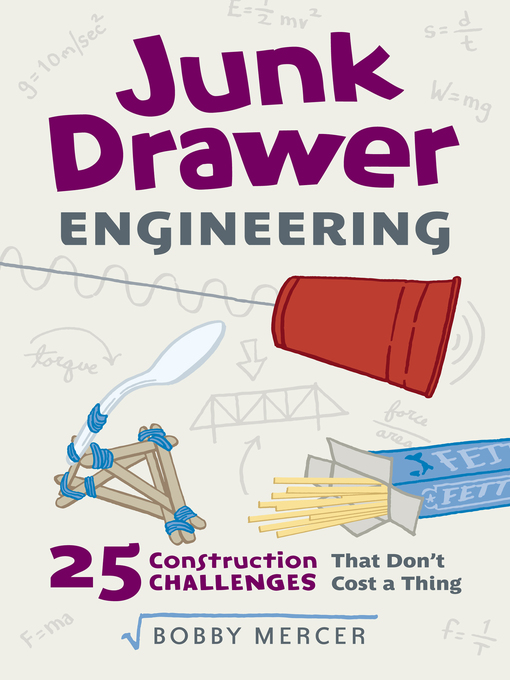Junk Drawer Engineering
25 Construction Challenges That Don't Cost a Thing
These 25 open-ended design challenges can be performed for just pennies . . . or less. Each project has a suggested materials list, step-by-step instructions with illustrations for one possible solution, and suggestions on how to adapt each challenge for different ages and skill levels. Educators and parents will find this title a handy resource to teach children problem-solving skills and applied physics, all while having a lot of fun.
-
Creators
-
Series
-
Publisher
-
Release date
May 1, 2017 -
Formats
-
Kindle Book
-
OverDrive Read
- ISBN: 9781613737194
- File size: 7926 KB
-
EPUB ebook
- ISBN: 9781613737194
- File size: 7926 KB
-
-
Languages
- English
-
Levels
- Lexile® Measure: 880
- Text Difficulty: 4-5
-
Reviews
-
Kirkus
March 15, 2017
Step-by-step suggestions for possible solutions to 25 engineering challenges use readily available materials.A high school physics teacher complements his Junk Drawer Physics (2014) and Junk Drawer Chemistry (2015) with this collection of engineering problems involving energy, structures, and waves. The materials he uses often come from the recycling bin or can be purchased inexpensively. He suggests appropriate modifications for different age levels. For most of his examples, simply constructing the gizmo--a windmill, a roller coaster, a bridge, a mechanical sound amplifier--is enough in early grades. Middle schoolers can add some math and further complications; high schoolers will use more-complex math to explain their results and more-challenging tools, such as hot glue guns. Step-by-step instructions are illustrated with his own black-and-white photographs. These pictures also demonstrate some useful techniques, such as the use of a protractor. Mercer stresses imaginative use and reuse of materials, experimentation, and finding alternate solutions, and he explains the science behind the solution he illustrates. The problems are not surprising: they can be found on many websites, in science magazines, and even in textbooks. But the compilation and suggested modifications for youngsters with different backgrounds and skill sets make this particularly welcome for science teachers as well as young learners who won't mind the crowded design. Hours of fun for STEM-inclined kids, parents, caregivers, and teachers. (Nonfiction. 8-16)COPYRIGHT(2017) Kirkus Reviews, ALL RIGHTS RESERVED.
-
School Library Journal
April 1, 2017
Gr 4-8-As the title suggests, most of the tasks described in this volume require readily available or recycled materials. The projects range in complexity from old-fashioned cup-and-string phones to -secret computer monitors- that demonstrate polarized light. They are divided into three general categories: energy (which features a variety of roller-coaster challenges), structures (buildings designed to hold a certain amount of weight), and waves (experiments with light and sound). Each project is presented with step-by-step instructions and illustrated with black-and-white photos, followed by an explanation of the science involved and ways to adapt the activity for different age groups. The strength of the text lies in the simple but clear descriptions of the science behind each challenge. Tips on how to extend or simplify each project for different ages are interesting and useful, too, although the author often proposes having middle and high school students -do the math- or calculate the forces involved, sometimes without providing much additional assistance. Readers without a background in physics may need to consult other sources. In addition, the projects are presented one after the other, with new ones often starting in the middle of a page, which makes the book harder to browse. VERDICT Aside from some minor formatting issues, this is a solid collection of STEM activities for tweens. Science teachers will want to investigate.-Ashley Larsen, Pacifica Libraries, CACopyright 2017 School Library Journal, LLC Used with permission.
-
Booklist
May 1, 2017
Grades 4-7 Makerspaces are an increasingly popular way to design and discover engineering, but many require costly supplies. In this activity book, part of the Junk Drawer Science series, former physics teacher Mercer shows that the same effect can be achieved with household items, such as bottle caps, cereal boxes, and paper-towel tubes. Whether it's designing a marbelous roller coaster, a marshmallow tower, or a homemade musical instrument, students can select from among 25 construction challenges, which are grouped into three broad categories: energy, structures, and waves. Each challenge includes a basic description of the task, a list of items needed, and step-by-step instructions, accompanied by photographs for reference. A summary explains the scientific principles behind each challenge, while a concluding Age-Appropriate Engineering section offers differentiation strategies for various ages and ability levels. While the directions are simple to follow, it's not often easy to distinguish where one challenge ends and another begins, so the table of contents is a must-read. A fun, hands-on resource for anyone who wants to inspire STEM-minded kids.(Reprinted with permission of Booklist, copyright 2017, American Library Association.)
-
Formats
- Kindle Book
- OverDrive Read
- EPUB ebook
subjects
Languages
- English
Levels
- Lexile® Measure:880
- Text Difficulty:4-5
Loading
Why is availability limited?
×Availability can change throughout the month based on the library's budget. You can still place a hold on the title, and your hold will be automatically filled as soon as the title is available again.
The Kindle Book format for this title is not supported on:
×Read-along ebook
×The OverDrive Read format of this ebook has professional narration that plays while you read in your browser. Learn more here.



